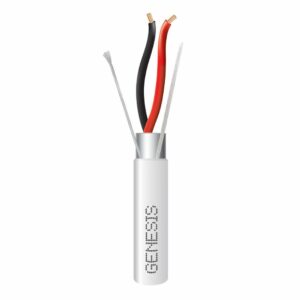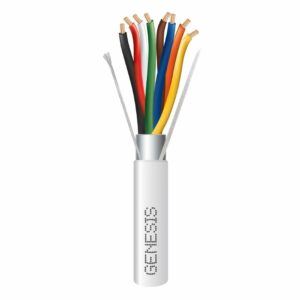It seems like such a trivial question to ask. Yet many may look at a full page of thermostat wire available and see things like 18/5 or “plenum-rated” and have no idea what all of it means. So today we’re going to break down the thermostat wire and strip back the details to make it easy for you to make an educated decision about what you’re buying. We’ll also take a look at its applications and what you should expect from this colorful bunch of wires.
Let’s start with the basics
We should probably begin with understanding the coloration of thermostat wiring and how it pertains to thermostats. All contractors and some handy homeowners have probably dealt with matching the right colored wire with its respective port, but what do these colors mean and how do they pertain to the thermostat your installing?
Simply put thermostat cabling consists of multiple strands of copper wiring individually wrapped with colored insulation using a protective coating to avoid electrocution or malfunctions. The biggest differences between these color-coated copper wires come down to conductors and sizing needed to communicate with the motherboard.
Each color and thermostat motherboard marking has different functions needed to power the device at hand. A very simple heat only or cool only thermostat usually requires only 2 wires to work because the controls needed are extremely basic like a light switch. As you work into more complex models like the new smart thermostats, more wiring comes into play to operate and power all the features the stat has to offer. Below you’ll see a breakdown of common functions for thermostat markings with their respective wires.

Sizing and Safety
Now when it comes to different types of thermostat wire, we run into a wide variety of sizes and standards that meet certain building criteria. The thermostat wire comes in a range of gauges which can be determined based on the number of conductors needed to power your thermostat/device. The most common size for wiring is 18 gauge because they typically come with 5 conductor wires which have become the standard for low voltage stats and HVAC devices.
Almost all HVAC systems in the United States will run off a 24V low voltage current. The only applications that don’t utilize the 24-volt system would be: Boilers, Electric Furnaces, Solid Fuel Stoves, and millivolt furnaces. Everything else should operate off 24V wiring.
Other wiring size options go from 16 to 20 gauge. Typically, 20 gauge is too thin to run lengthy amounts of wire but works well in shorter applications. A good rule of thumb to remember about wiring is the thicker it is, the less electrical resistance. Because of this, 16 gauge is a decent option for running long amounts of wire through large building or home settings. The only setback with this sizing can be fitting through socket plates because of its thickness.
Plenum Rated
One of the final hurdles to choosing the right thermostat wire for your job is based on the guidelines of the NFPA. The NFPA (National Fire Protection Association) requires any wiring ran through plenum spaces, meaning any part of a building that facilitates air circulation for HVAC, to be coated in a fire-retardant plastic. Because of this, you’ll find lots of different “plenum rated” thermostat wiring available for jobs that require running wire in these areas. Space between a structure’s ceiling, dropped ceiling, or under a raised floor is also considered plenum. This is an effort to fight potential toxins in the air from wiring in an emergency fire situation.
It’s safe to say we’ve covered a slew of wiring terms, sizing options, and applications you’ll find for thermostat wire. Hopefully, this builds some confidence in purchasing decisions and leads you towards the right wire for your job. Remember to call us at (844) 727-8748 if you have any questions or concerns about finding the right equipment for your next big project.
-
MSRP: $204.99You save 15%
-
MSRP: $425.20You save 15%
-
MSRP: $804.99You save 15%



